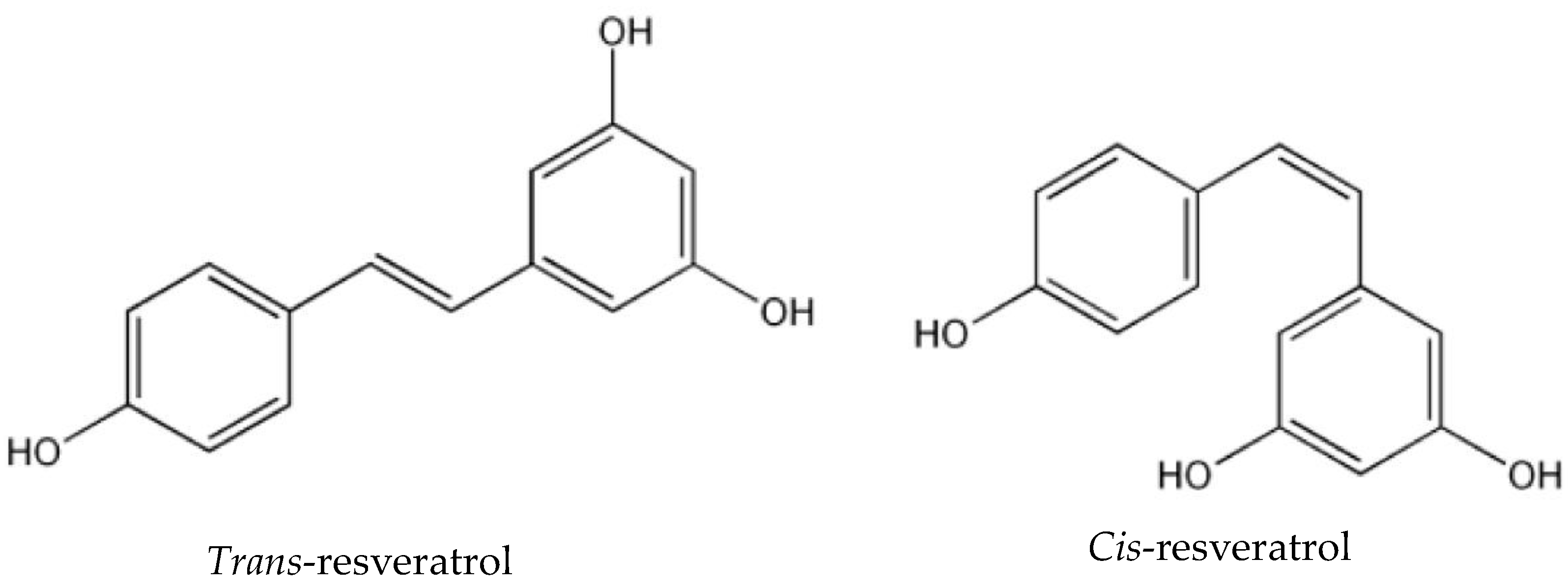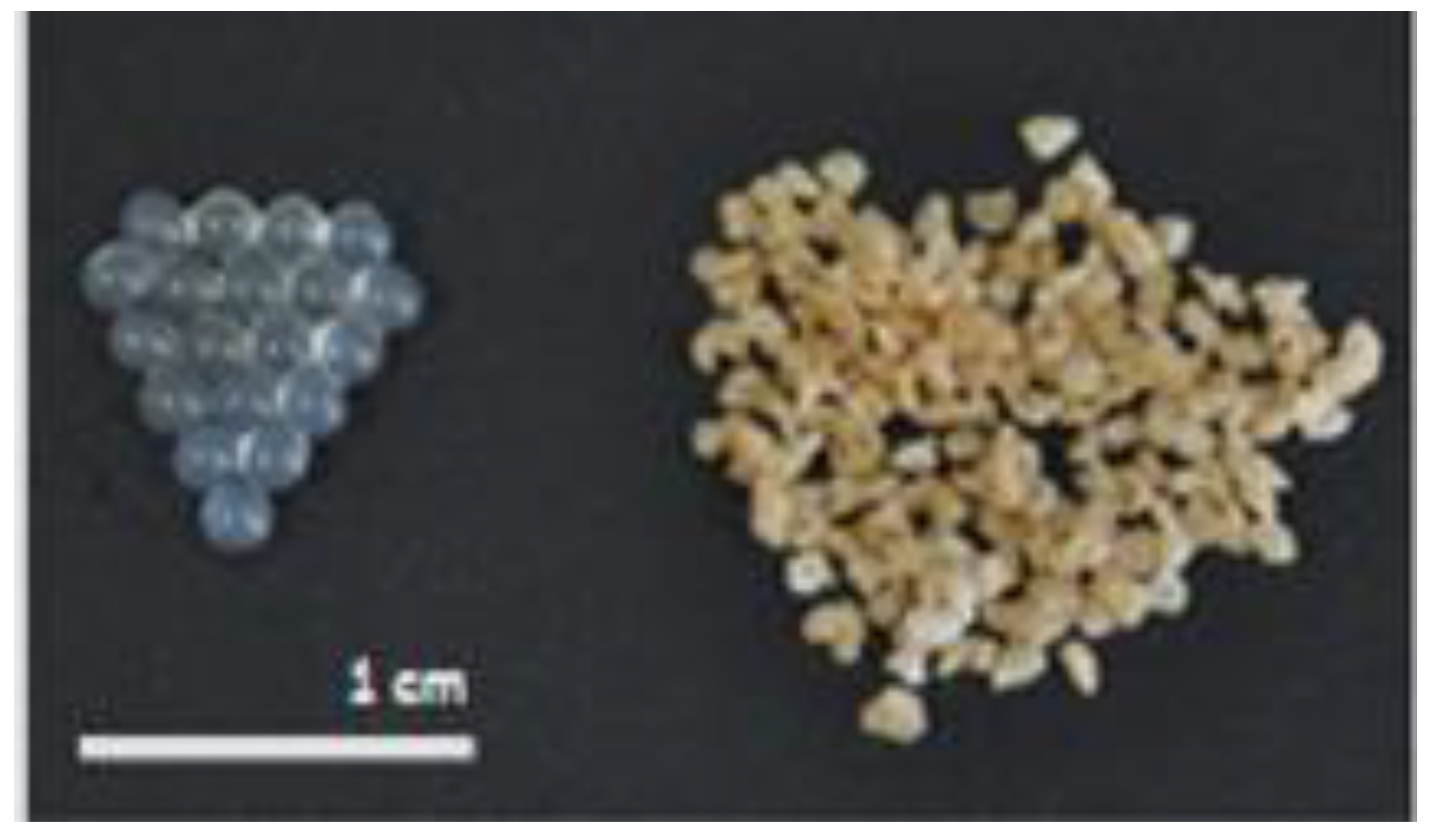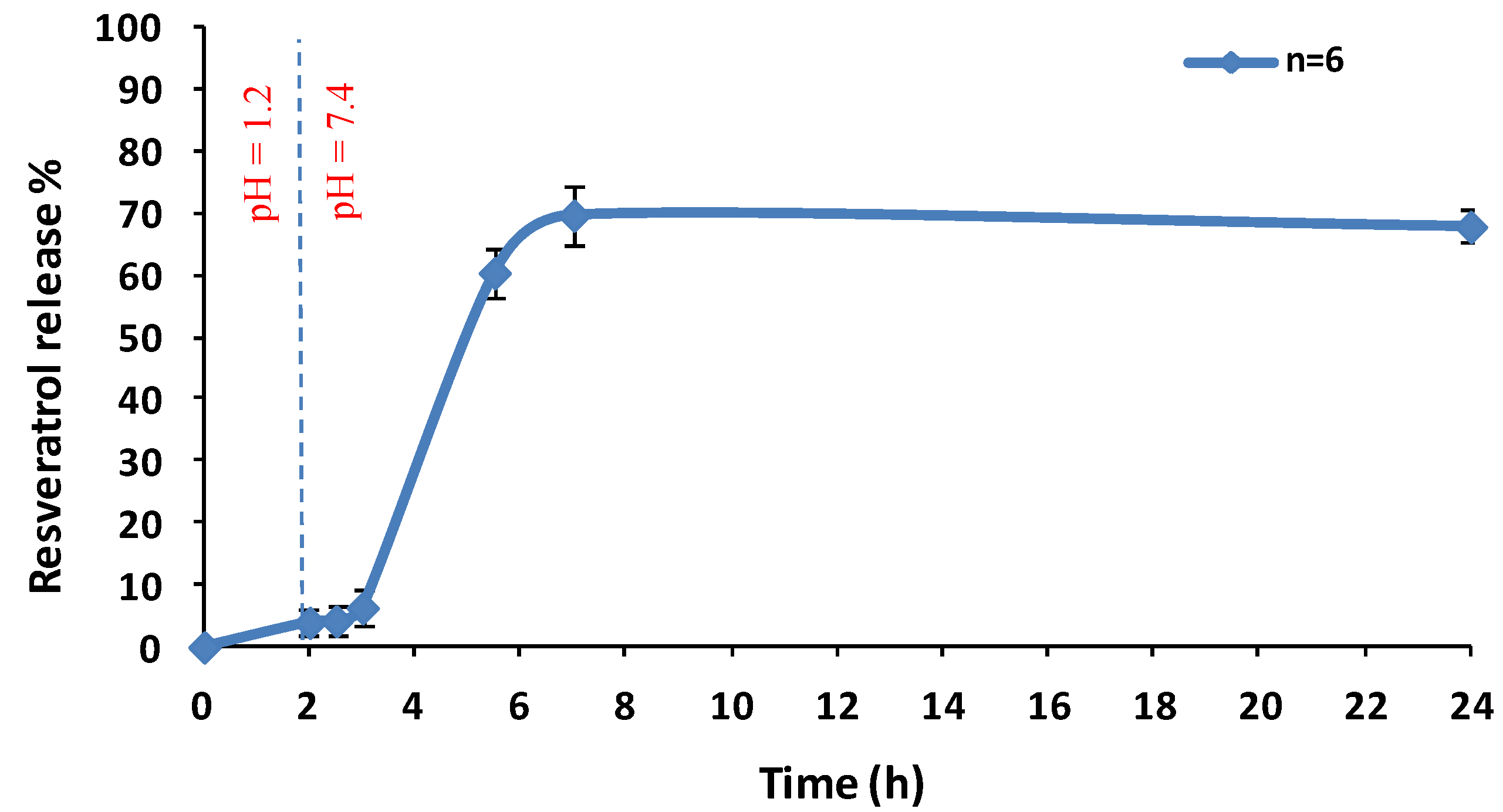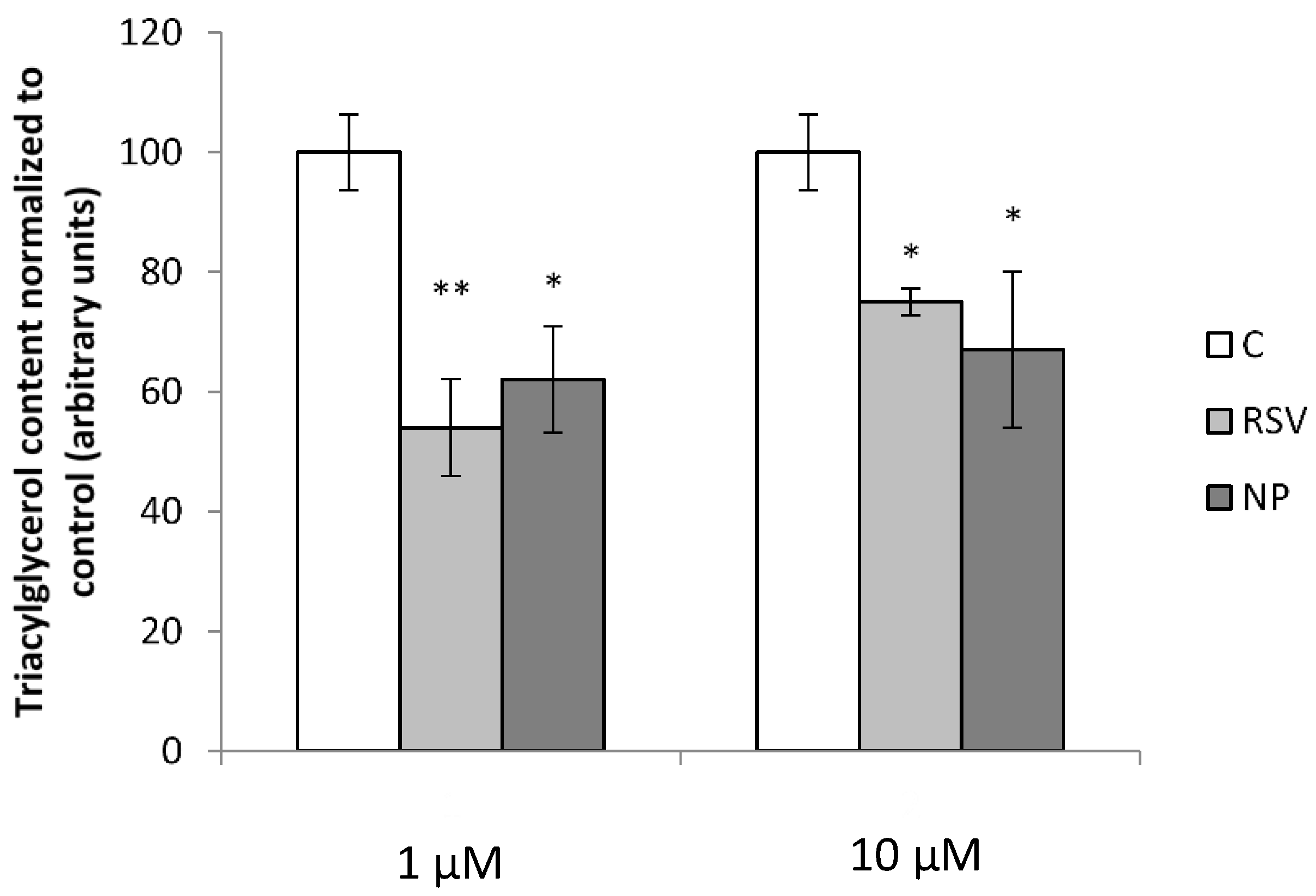Preparation and Characterization of Resveratrol Loaded Pectin/Alginate Blend Gastro-Resistant Microparticles
Abstract
:1. Introduction
2. Results
2.1. Validation of the Quantification Technique of Resveratrol by High-Performance Liquid Chromatographic (HPLC)
2.2. Particle Size and Morphology
2.3. Encapsulation Efficiency (EE)
2.4. Drug Release Study: Resveratrol Release from Microparticles
2.5. In Vitro Bioactivity Study: Measurement of Triacylglycerol Content in Adipocytes
3. Discussion
4. Materials and Methods
4.1. Materials
4.2. Preparation of Microparticles
4.3. Development and Validation of an HPLC Method for the Quantification of Resveratrol
4.4. Characterization of Microparticles
4.4.1. Particle Size
4.4.2. Encapsulation Efficiency (EE%)
4.4.3. Dissolution Assay
4.5. In Vitro Bioactivity Assay
4.5.1. Experimental Design
4.5.2. Cell Treatment
4.5.3. Measurement of Triacylglycerol Content in Adipocytes
4.5.4. Statistical Analysis
5. Conclusions
Author Contributions
Funding
Acknowledgments
Conflicts of Interest
References
- Shi, G.; Rao, L.; Yu, H.; Xiang, H.; Yang, H.; Ji, R. Stabilization and encapsulation of photosensitive resveratrol within yeast cell. Int. J. Pharm. 2008, 349, 83–93. [Google Scholar] [CrossRef] [PubMed]
- Wu, C.; Yang, J.; Wang, F.; Wang, X. Resveratrol: Botanical origin, pharmacological activity and applications. Chin. J. Nat. Med. 2013, 11, 1–15. [Google Scholar] [CrossRef]
- Frémont, L. Biological effects of resveratrol. Life Sci. 2000, 66, 663–673. [Google Scholar] [CrossRef]
- Andres-Lacueva, C.; Macarulla, M.T.; Rotches-Ribalta, M.; Boto-Ordóñez, M.; Urpi-Sarda, M.; Rodríguez, V.M.; Portillo, M.P. Distribution of resveratrol metabolites in liver, adipose tissue, and 2 skeletal muscle in rats fed different doses of this polyphenol. J. Agric. Food Chem. 2012, 60, 4833–4840. [Google Scholar] [CrossRef] [PubMed]
- Rotches-Ribalta, M.; Andres-Lacueva, C.; Estruch, R.; Escribano, E.; Urpi-Sarda, M. Pharmacokinetics of resveratrol metabolic profile in healthy humans after moderate consumption of red wine and grape extract tablets. Pharmacol. Res. 2012, 66, 375–382. [Google Scholar] [CrossRef] [PubMed]
- Amri, A.; Chaumeil, J.C.; Sfar, S.; Charrueau, C. Administration of resveratrol: What formulation solutions to bioavailability limitations? J. Controlled Release 2012, 158, 182–193. [Google Scholar] [CrossRef] [PubMed]
- Liu, L.; Fishman, M.L.; Kost, J.; Hicks, K.B. Pectin-based systems for colon-specific drug delivery via oral route. Biomaterials 2003, 24, 3333–3343. [Google Scholar] [CrossRef]
- Cantalapiedra, J.; Dirección General de Farmacia y Productos Sanitarios; Servicio de Información de Medicamentos; Servicio de Gestión de Banco de Datos. Diccionario de Excipientes de las Especialidades Farmacéuticas Españolas; Ministerio de Sanidad y Consumo: Madrid, Spain, 1989; pp. 9–109.
- Das, S.; Ng, K. Colon-specific delivery of resveratrol: Optimization of multi-particulate calcium-pectinate carrier. Int. J. Pharm. 2010, 385, 20–28. [Google Scholar] [CrossRef] [PubMed]
- Simonoska Crcarevska, M.; Glavas Dodov, M.; Goracinova, K. Chitosan coated Ca–alginate microparticles loaded with budesonide for delivery to the inflamed colonic mucosa. Eur. J. Pharm. Biopharm. 2008, 68, 565–578. [Google Scholar] [CrossRef] [PubMed]
- Cerchiara, T.; Bigucci, F.; Corace, G.; Zecchi, V.; Luppi, B. Eudragit-coated albumin nanospheres carrying inclusion complexes for oral administration of indomethacin. J. Incl. Phenom. Macrocycl. Chem. 2011, 71, 129–136. [Google Scholar] [CrossRef]
- Sandolo, C.; Péchiné, S.; Le Monnier, A.; Hoys, S.; Janoir, C.; Coviello, T.; Alhaique, F.; Collignon, A.; Fattal, E.; Tsapis, N. Encapsulation of Cwp84 into pectin beads for oral vaccination against clostridium difficile. Eur. J. Pharm. Biopharm. 2011, 79, 566–573. [Google Scholar] [CrossRef] [PubMed]
- Quality Guidelines. Available online: www.ich.org/products/guidelines/quality/article/quality-guidelines.html (accessed on 14 June 2018).
- Disolution test for solid dosage forms, 2.9.3. In European Pharmacopeia 7.0; Council of Europe: Strasbourg, France, 2011; Volume 1, pp. 256–263.
- Walle, T.; Hsieh, F.; DeLegge, M.H.; Oatis, J.E., Jr.; Walle, U.K. High absorption but very low bioavailability of oral resveratrol in humans. Drug Metab. Dispos. 2004, 32, 1377–1382. [Google Scholar] [CrossRef] [PubMed]
- Baile, C.A.; Yang, J.Y.; Rayalam, S.; Hartzell, D.L.; Lai, C.Y.; Andersen, C.; Della-Fera, M.A. Effect of resveratrol on fat mobilization. Ann. N. Y. Acad. Sci. 2011, 1215, 40–47. [Google Scholar] [CrossRef] [PubMed] [Green Version]
- Picard, F.; Kurtev, M.; Chung, N.; Topark-Ngarm, A.; Senawong, T.; Machado De Oliveira, R.; Leid, M.; McBurney, M.W.; Guarente, L. Sirt1 promotes fat mobilization in white adipocytes by repressing PPAR-gamma. Nature 2004, 429, 771–776. [Google Scholar] [CrossRef] [PubMed]
- Lasa, A.; Schweiger, M.; Kotzbeck, P.; Churruca, I.; Simon, E.; Zechner, R.; Portillo, M.P. Resveratrol regulates lipolysis via adipose triglyceride lipase. J. Nutr. Biochem 2012, 23, 379–384. [Google Scholar] [CrossRef] [PubMed]
- Kim, S.; Jin, Y.; Choi, Y.; Park, T. Resveratrol exerts anti-obesity effects via mechanisms involving down-regulation of adipogenic and inflammatory processes in mice. Biochem. Pharmacol. 2011, 81, 1343–1351. [Google Scholar] [CrossRef] [PubMed]
- Bhatt, J.K.; Thomas, S.; Nanjan, M.J. Resveratrol supplementation improves glycemic control in type 2 diabetes mellitus. Nutr. Res. 2012, 32, 537–541. [Google Scholar] [CrossRef] [PubMed]
- Faghihzadeh, F.; Adibi, P.; Hekmatdoost, A. The effects of resveratrol supplementation on cardiovascular risk factors in patients with non-alcoholic fatty liver disease: a randomised, double-blind, placebo-controlled study. Br. J. Nutr. 2015, 114, 796–803. [Google Scholar] [CrossRef] [PubMed]
- Alberdi, G.; Rodríguez, V.M.; Miranda, J.; Macarulla, M.T.; Arias, N.; Andrés-Lacueva, C.; Portillo, M.P. Changes in white adipose tissue metabolism induced by resveratrol in rats. Nutr. Metab. (Lond) 2011, 8, 29. [Google Scholar] [CrossRef] [PubMed] [Green Version]
- Boocock, D.J.; Faust, G.E.; Patel, K.R.; Schinas, A.M.; Brown, V.A.; Ducharme, M.P.; Booth, T.D.; Crowell, J.A.; Perloff, M.; Gescher, A.J.; et al. Phase I dose escalation pharmacokinetic study in healthy volunteers of resveratrol, a potential cancer chemopreventive agent. Cancer Epidemiol. Biomarkers Prev. 2007, 16, 1246–1252. [Google Scholar] [CrossRef] [PubMed]
- Marier, J.F.; Vachon, P.; Gritsas, A.; Zhang, J.; Moreau, J.P.; Ducharme, M.P. Metabolism and disposition of resveratrol in rats: extent of absorption, glucuronidation, and enterohepatic recirculation evidenced by a linked-rat model. J. Pharmacol. Exp. Ther. 2002, 302, 369–373. [Google Scholar] [CrossRef] [PubMed]
- Cho, S.J.; Jung, U.J.; Choi, M.S. Differential effects of low-dose resveratrol on adiposity and hepatic steatosis in diet-induced obese mice. Br. J. Nutr. 2012, 108, 2166–2175. [Google Scholar] [CrossRef] [PubMed]
Sample Availability: Not available. |




| Parameter | Especification | ||
|---|---|---|---|
| Selectivity | Identification | - | |
| Resolution | Rs > 1.5 | ||
| Absence of interference | no interferences | ||
| Linearity | Correlation coefficient | r ≥ 0.999 | |
| C.V. response factors | C.V. ≤ 2% | ||
| Relative error percentage | ≤2% | ||
| Slope linearity test | texp > ttable | ||
| Slope confidence intervals | No include 0 | ||
| Test of proportionality | texp < ttable | ||
| Intercept confidence intervals | Include 0 | ||
| Repeatability of Instrumental System | C.V. | C.V. < 1.37% | |
| Repeatability of the Method | C.V. | C.V. < 1.94% | |
| Intermediate Precision | C.V. individuals | C.V. < 1.94% | |
| C.V. intermediate | C.V. < 3.88% | ||
| Recovery percentage | Recovery | 98.0–102.0% | |
| Relative error percentage | ≤2% | ||
| Test for equality of variances | Gexp < Gtable | ||
| Robustness | Influence of analyst | C.V. | C.V. < 3.88% |
| Influence of analysis temperature | C.V. | C.V. < 1.94% | |
| Stability | Standard | Concentration in relation to time 0 | 98.0–102.0% |
| Sample | |||
© 2018 by the authors. Licensee MDPI, Basel, Switzerland. This article is an open access article distributed under the terms and conditions of the Creative Commons Attribution (CC BY) license (http://creativecommons.org/licenses/by/4.0/).
Share and Cite
Gartziandia, O.; Lasa, A.; Pedraz, J.L.; Miranda, J.; Portillo, M.P.; Igartua, M.; Hernández, R.M. Preparation and Characterization of Resveratrol Loaded Pectin/Alginate Blend Gastro-Resistant Microparticles. Molecules 2018, 23, 1886. https://doi.org/10.3390/molecules23081886
Gartziandia O, Lasa A, Pedraz JL, Miranda J, Portillo MP, Igartua M, Hernández RM. Preparation and Characterization of Resveratrol Loaded Pectin/Alginate Blend Gastro-Resistant Microparticles. Molecules. 2018; 23(8):1886. https://doi.org/10.3390/molecules23081886
Chicago/Turabian StyleGartziandia, Oihane, Arrate Lasa, Jose Luis Pedraz, Jonatan Miranda, Maria Puy Portillo, Manoli Igartua, and Rosa Maria Hernández. 2018. "Preparation and Characterization of Resveratrol Loaded Pectin/Alginate Blend Gastro-Resistant Microparticles" Molecules 23, no. 8: 1886. https://doi.org/10.3390/molecules23081886






